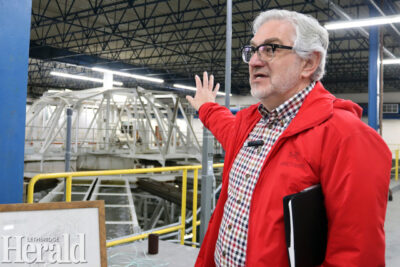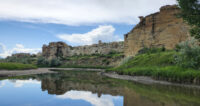Water treatment plant nearing capacity as City eyes drought conditions
By Lethbridge Herald on February 12, 2024.
 Doug Kaupp, the City’s general manager of water and wastewater treatment, speaks about the systems and infrastructure involved in the water treatment process while leading a tour on Monday at the water treatment plant.
Herald photo by Alejandra Pulido-Guzman
Doug Kaupp, the City’s general manager of water and wastewater treatment, speaks about the systems and infrastructure involved in the water treatment process while leading a tour on Monday at the water treatment plant.
Herald photo by Alejandra Pulido-GuzmanAlejandra Pulido-Guzman – LETHBRIDGE HERALD – apulido@lethbridgeherald.com
Members of the media had the opportunity to tour the water treatment plant Monday to learn about the process river water goes through before reaching residents.
The tour was led by general manager of water and wastewater with the City of Lethbridge, Doug Kaupp, who spoke to reporters after the tour and explained the objective was in part to showcase the fact that the plant, which is over 40 years old, is approaching capacity.
“Our community has grown a lot since 1980,” said Kaupp. “We now have regional customers and new big industries, and with hot dry summers we’ve been setting records of maximum-day demands.”
He said the average production at the water treatment plant is around 60 million litres a day, with winter demands being about 50 million litres a day, and in the summer with a demand that can exceed 130 million litres a day. The plant capacity is 150 million litres a day.
“On our biggest days in the last few summers, we have been right around 90-per-cent capacity,” Kaupp said. “Those 50 million litres a day that’s leaving the plant today is all going to be used in 24 hours between Lethbridge as a community, as well as our regional customers like Picture Butte and Coaldale. The McCains plant gets water from Lethbridge, our big industries within town, Cavendish and Black Velvet, and the cheese plant by Diamond City use quite a bit of city water.”
Kaupp said they have capital plans to expand the facility as well as the waste treatment plant, to accommodate for the increasing demands of both because of population growth.
“We have expansion plans in a couple phases, and the first phase would be to add 30 million litres of capacity to the plant, so to go from 150 million litres to 180 million litres, and depending on the pace of growth, that could last for a decade or two before we have to go into the next phase.”
Kaupp also spoke about the drought conditions the city is facing and what that could mean for the summer months if conditions do not change.
“The storage reservoirs are as low as I’ve ever seen them in 30 years, and currently the snowpack is well below normal, so the stage is pretty much being set for some kind of drought response, so stay tuned.”
He said residents will probably be priding themselves in brown lawns and dirty cars and any other way they can demonstrate they are not wasting the precious resource water is.
“All outdoor use is pretty easy to curtail; so lawn watering, washing driveways and car washing and that sort of thing, but inside your home, making sure that your washing machine and dishwasher is full before you run it, so that in a given week there’s fewer runs.”
He added that shorter showers would help conserve water, as well, but that would not be something that would be monitored or restricted if the drought situation ever calls for mandatory conservation of water.
“This is quite unprecedented, as a community we’ve never had to restrict days of watering, and all of the restrictions that we’ve had historically have been short lived, in the context of the flood of 95, or mechanical failures in 2017.”
He said sometimes they have equipment failures that can last for two or three days, where they have been challenged to meet demands, but unlike floods, droughts can extend beyond 10 days.
“I expect that we could be in for a long stretch through this summer.”
When it comes to conserving water at the water treatment and wastewater treatment plants, the water treatment plant is more efficient than 10 years ago at recycling some of the waste streams, while they have some projects to improve the efficiency of the wastewater treatment plant, to be able to use less potable water.
“Corporate wide we’ll be looking at different ways to save water in city buildings and to address parks watering and irrigation of open space in general, arterial landscaping on major roads. It’s nice to have but when we’re short water I suspect that those would be cut back.”
19-18





[…] Doug Kaupp, the City’s general manager of water and wastewater treatment, led a tour of the water treatment plant to show members of the media the process river water goes through before reaching residents. Kaupp explained that the plant, over 40 years old, is approaching capacity due to the community’s growth and increased demand. The average production at the water treatment plant is around 60 million liters a day, with a capacity of 150 million liters a day. Kaupp also mentioned their plans to expand the facility to accommodate for population growth. Furthermore, he addressed the drought conditions the city is facing and discussed potential drought response measures, such as water conservation efforts. He stressed the need for residents to conserve water, both outdoors and indoors, as the city prepares for possible water use restrictions. In addition, Kaupp spoke about the plans to improve the efficiency of the wastewater treatment plant and the need to save water in city buildings and open spaces. He also mentioned the low snowpack and the potential for a long stretch of drought through the summer. This is important for people to be aware of, given the potential impacts on daily life. Source link […]